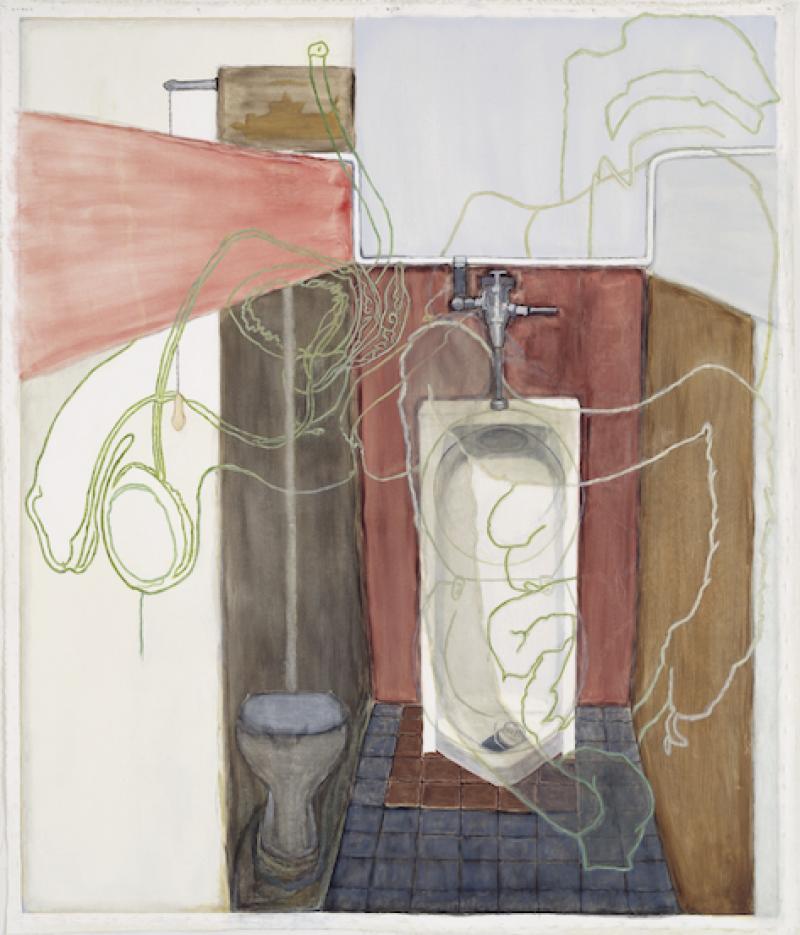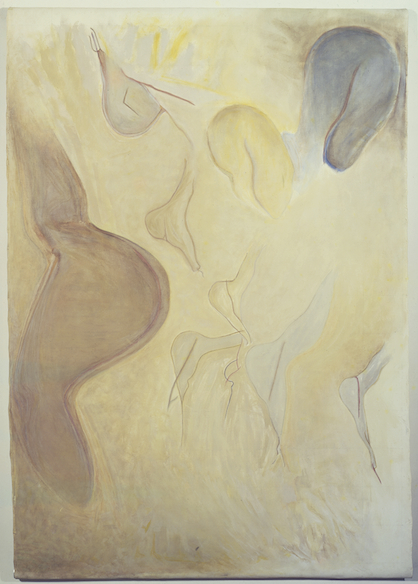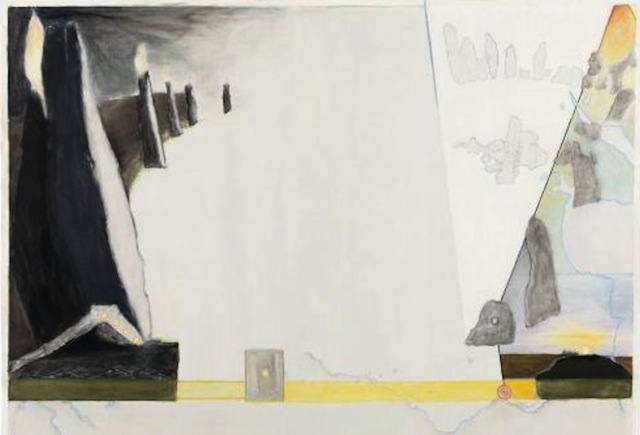Jo Baer, Camden Arts Centre | reviews, news & interviews
Jo Baer, Camden Arts Centre
Jo Baer, Camden Arts Centre
The Minimalist who rejected abstraction for figurative painting. Or did she?

At 86, Jo Baer is still painting vigorously. In the mid 1960s, she was an established New York Minimalist along with artists like Carl Andre and Sol Lewitt; but while they continued to explore abstraction, she changed tack – dramatically, or so it seemed. In the mid 1970s, she turned toward figuration declaring that the “naivety” of Minimalism (its refusal to engage with events in the real world) no longer made it relevant.
In the early days, her attention focused on the edges of the paintings. Traditionally, this is the boundary between three-dimensional reality and the illusory realm of the canvas, but rather than windows onto an imaginary world, Baer’s abstract paintings function as objects in the here and now.
Four-inch thick stretchers turn them into slabs whose sides are as important as their front surfaces. Framing a blank centre, bands of restrained colour typically hug the edges and sides of what she dubbed “Wraparound” paintings. H. Arcuata, 1971, for instance, hangs horizontally on the wall like a radiator. Rather like the design on a Clarice Cliff teacup, a fin of black, green and terracotta stripes glides along the top edge before sliding down the front surface.
In 1975 Baer left the Big Apple, rented a 12th-century castle in Ireland and gradually left abstraction behind. The Old Year, 1975, is one of her first, tentative forays into figuration. Nothing could be more different from the hard-edged clarity and assertiveness of her Minimalist paintings than this enigmatic exploration. The thick stretcher is still a feature, but instead of emphasising the immediacy and physicality of the painting, it magically introduces a sense of time. Representing the moon, 13 blobs traverse misty overlays of orange and pale green to bounce across the canvas. The paint coalesces into three indistinct blocks of orange that seem to be moving across the surface, like clouds drifting across the sky.
 Soon she abandon the stretchers and pinned the canvases directly onto the wall to emphasise their flatness. From now on, any sense of space is illusory and highly enigmatic. At first sight Facing, 1979 (pictured left) looks like a cluster of arabesques emerging from a pale khaki ground. Gradually one recognises the shapes as female buttocks and thighs curled suggestively. Similarities with ancient cave paintings of bison and deer encourage one to see these bodies as prey and to read the painting as an invocation, or the distillation of desire.
Soon she abandon the stretchers and pinned the canvases directly onto the wall to emphasise their flatness. From now on, any sense of space is illusory and highly enigmatic. At first sight Facing, 1979 (pictured left) looks like a cluster of arabesques emerging from a pale khaki ground. Gradually one recognises the shapes as female buttocks and thighs curled suggestively. Similarities with ancient cave paintings of bison and deer encourage one to see these bodies as prey and to read the painting as an invocation, or the distillation of desire.
In Of a Fearful Symmetry, 1991, the reference to cave paintings is even more overt. Hand prints are repeated obsessively, as though desperately trying to make their presence felt before they fade away or morph. They appear on a curtain above two ballet dancers wearing leotards decorated with muscles and bones, as if they had been flayed. Three mythic beasts prance about orgiastically, while the legs of a man in riding boots introduce an unwelcome whiff of masculine authority. The watery beauty of this strange scene creates a mood of dreamy uncertainty. For this disparate array of images did Baer draw on something seen or dreamt, or were they assembled for the first time here on canvas?
From now on, multi-layered meanings become the norm. While the matter-of-factness of the Minimalist canvases is replaced by complexity, suggestiveness and ambiguity, each work acquires a subtitle indicative of a secondary reading. Shrine of the Piggies..., 2000 (main picture), is a delicate rendition of a pissoir with ochre walls and a tiled floor. Over the beautifully observed fixtures floats some plumbing of a different kind; diagrams of the male urinary tract and colon add a sordid note to the scene. An aggressive addendum to the title – The Pigs Hog it All and Defecate and Piss on Where From They Get It and With Whom They Will Not Share. That’s It – suggests that this apparently innocuous image is actually a diatribe against patriarchy.
 Baer now lives in Amsterdam, but in her most recent series of paintings the Irish landscape features even more clearly. In the Land of the Giants, 2012 (pictured right), shows the artist standing beside the Hurlstone, an ancient monolith with a perfect circle bored through its middle, which according to legend, was thrown there by a giant. Above her diminutive figure a black hole resembling the eye of a camera or telescope opens to receive the storm of rocks hurtling through the heavens and spiralling towards its interior. The giant hurling the stones looks like a classical Greek statue. The subtitle Spirals and Stars encourages one to see beyond the literal elements to the geometry structuring the composition and the links between ancient mythology and modern physics which the image implies.
Baer now lives in Amsterdam, but in her most recent series of paintings the Irish landscape features even more clearly. In the Land of the Giants, 2012 (pictured right), shows the artist standing beside the Hurlstone, an ancient monolith with a perfect circle bored through its middle, which according to legend, was thrown there by a giant. Above her diminutive figure a black hole resembling the eye of a camera or telescope opens to receive the storm of rocks hurtling through the heavens and spiralling towards its interior. The giant hurling the stones looks like a classical Greek statue. The subtitle Spirals and Stars encourages one to see beyond the literal elements to the geometry structuring the composition and the links between ancient mythology and modern physics which the image implies.
In Dawn (Lines and Destinations), 2011 (pictured below), figurative elements such as standing stones, the rising sun and a map of the Irish coastline function in much the same way as the bands of colour that frame the blank centre of the wraparound paintings. Bracketing empty space, they leave us in no doubt that, although this landscape may be inspired by an actual place, first and foremost it is a construct of the mind.
 The abstract and figurative elements in the work are allowed to cohabit and, given equal weight, are able to underpin one another. It's like a homecoming in which the beginning and the end of Jo Baer’s career – to date – unite into a single declaration concerning the place of painting in the world (physically and metaphorically) and its relationship to the continuum of ideas that has informed human experience since time immemorial.
The abstract and figurative elements in the work are allowed to cohabit and, given equal weight, are able to underpin one another. It's like a homecoming in which the beginning and the end of Jo Baer’s career – to date – unite into a single declaration concerning the place of painting in the world (physically and metaphorically) and its relationship to the continuum of ideas that has informed human experience since time immemorial.
Explore topics
Share this article
The future of Arts Journalism
You can stop theartsdesk.com closing!
We urgently need financing to survive. Our fundraising drive has thus far raised £49,000 but we need to reach £100,000 or we will be forced to close. Please contribute here: https://gofund.me/c3f6033d
And if you can forward this information to anyone who might assist, we’d be grateful.

Subscribe to theartsdesk.com
Thank you for continuing to read our work on theartsdesk.com. For unlimited access to every article in its entirety, including our archive of more than 15,000 pieces, we're asking for £5 per month or £40 per year. We feel it's a very good deal, and hope you do too.
To take a subscription now simply click here.
And if you're looking for that extra gift for a friend or family member, why not treat them to a theartsdesk.com gift subscription?
more Visual arts
 'We are bowled over!' Thank you for your messages of love and support
Much-appreciated words of commendation from readers and the cultural community
'We are bowled over!' Thank you for your messages of love and support
Much-appreciated words of commendation from readers and the cultural community
 Folkestone Triennial 2025 - landscape, seascape, art lovers' escape
Locally rooted festival brings home many but not all global concerns
Folkestone Triennial 2025 - landscape, seascape, art lovers' escape
Locally rooted festival brings home many but not all global concerns
 Sir Brian Clarke (1953-2025) - a personal tribute
Remembering an artist with a gift for the transcendent
Sir Brian Clarke (1953-2025) - a personal tribute
Remembering an artist with a gift for the transcendent
 Emily Kam Kngwarray, Tate Modern review - glimpses of another world
Pictures that are an affirmation of belonging
Emily Kam Kngwarray, Tate Modern review - glimpses of another world
Pictures that are an affirmation of belonging
 Kiefer / Van Gogh, Royal Academy review - a pairing of opposites
Small scale intensity meets large scale melodrama
Kiefer / Van Gogh, Royal Academy review - a pairing of opposites
Small scale intensity meets large scale melodrama
 Jenny Saville: The Anatomy of Painting, National Portrait Gallery review - a protégé losing her way
A brilliant painter in search of a worthwhile subject
Jenny Saville: The Anatomy of Painting, National Portrait Gallery review - a protégé losing her way
A brilliant painter in search of a worthwhile subject
 Abstract Erotic, Courtauld Gallery review - sculpture that is sensuous, funny and subversive
Testing the boundaries of good taste, and winning
Abstract Erotic, Courtauld Gallery review - sculpture that is sensuous, funny and subversive
Testing the boundaries of good taste, and winning
 Edward Burra, Tate Britain review - watercolour made mainstream
Social satire with a nasty bite
Edward Burra, Tate Britain review - watercolour made mainstream
Social satire with a nasty bite
 Ithell Colquhoun, Tate Britain review - revelations of a weird and wonderful world
Emanations from the unconscious
Ithell Colquhoun, Tate Britain review - revelations of a weird and wonderful world
Emanations from the unconscious
 Rachel Jones: Gated Canyons, Dulwich Picture Gallery review - teeth with a real bite
Mouths have never looked so good
Rachel Jones: Gated Canyons, Dulwich Picture Gallery review - teeth with a real bite
Mouths have never looked so good
 Yoshitomo Nara, Hayward Gallery review - sickeningly cute kids
How to make millions out of kitsch
Yoshitomo Nara, Hayward Gallery review - sickeningly cute kids
How to make millions out of kitsch
 Hamad Butt: Apprehensions, Whitechapel Gallery review - cool, calm and potentially lethal
The YBA who didn’t have time to become a household name
Hamad Butt: Apprehensions, Whitechapel Gallery review - cool, calm and potentially lethal
The YBA who didn’t have time to become a household name

Add comment